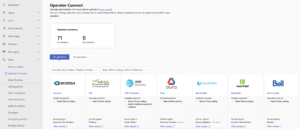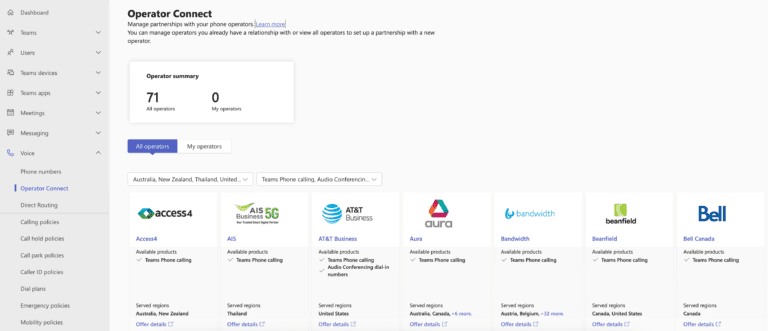Operator Connect is the flagship product you should be using if you’re thinking of connecting your phone lines to Microsoft Teams. At the time of writing, 71 different operators from all over the world have joined the program that boasts best in class connectivity for your telephony with minimal effort (on your part).
Prior to Operator Connect, your choices for telephony connectivity was limited to Microsoft Calling Plans or Direct Routing. While calling plans from Microsoft are a turnkey solution, you’re limited by coverage and cost. Direct Routing enabled you to go to market and find the best deal any provider. If that provider used a certified Session Border Controller, such as AudioCodes, Ribbon, and Oracle etc. you benefitted from a ‘certified’ solution.
Direct Routing for Microsoft Teams
Direct Routing was the most obvious, and in many cases, only choice for customers wanting Teams telephony. The result of having such an open and low investment connectivity method gave rise to a massive influx of would-be Direct Routing Providers. All they need is a certified SBC, an internet connection and a wholesale SIP trunk with a telecom reseller, and violla, DRaaS provider was born.
As strong as the market became for Direct Routing, the overhead of these services is huge for customers. Connectivity over the internet meant that both Microsoft and the DR provider’s voice quality SLAs were not worth the paper they were written on. Each could blame the carrier network between platforms (internet) as the root cause of any problem. Support hierarchy for customers are complicated with them having to manage 3 or more vendors (Microsoft, Carrier, SBC vendor / support) within a simple call path.
Flexibility in voice features and routing reduced with aaS versions of Direct Routing so customers either had to invest more in updating systems they didn’t plan to or find workarounds that cost time and money to maintain.
How Operator Connect Solves These Problems
Operator Connect is Microsoft’s solution to some of these service problems. The main ones being voice quality, simplified support, and an SLA that actually works.
To be an Operator, the carrier must meet a design standard for infrastructure and network as set out by Microsoft. This involves peering between Microsoft and the Operator network using the Microsoft Azure Peering Service for Communications, a dedicated network that is designed to carry voice data and maintain quality of service.


Infrastructure wise, the carrier must have geo-resilient SBCs within their network and independent 10Gbps connections to Microsoft Teams in at least 2 Azure regions. From a configuration perspective, the carrier must pass a rigorous design review with Microsoft adhering to specific configuration principles. Only when Microsoft have validated that the carrier’s infrastructure and networking, will they be activated on the program.
Every call that transits between the Operator and Microsoft is measured for quality. Microsoft have continuous test call routines which will capture any degradation in quality or non conformance with design. Any issues are resolved automatically between Microsoft and the Operator, removing the need for you to be involved.
With Microsoft and the Operator now working together to provide a single managed service for your telephony you benefit from a higher level of service.
Operators are provided with API access to Teams that is not publicly available. They are able to provision numbers directly into your Teams tenant without involving you. It is a much cleaner, solution to Teams telephony than Direct Routing, and importantly, more reliable.
A reward to the Operator for being on the program is their logo prestigiously placed within the Teams Admin Center.

Is Operator Connect Heading For Problems?
If your Operator is listed here, all it will take is a simple phone call to them to order your Teams telephony solution. Once ordered, your numbers will appear in Teams like magic and you’ll be able to make and receive calls.
However, if your provider is not listed here and you want to benefit from Operator Connect, what options do you have?
With 71 and counting operators how do you know which operator to choose from? Within the Teams Admin Center you can narrow down the available operators by choosing your country availability.
In an ideal world, you’d prefer a single Operator to provide you dial tone in each of your operating countries. However, this may not be possible and you’ll have to choose multiple operators. This shouldn’t be much of a concern as all operators go through the same onboarding process. So you can be sure of the same level of service from each operator.
This is a problem for Operators. It is what I call the ‘NASCAR’ problem. In NASCAR, each team is provided with the same chassis and engine and development rights are very limited. This ensures that there is never a huge difference in car performance unlike say, Formula One. The result is that races are closer and the difference between winning and not come down to team strategy and the driver.
With Operator Connect, it is similar. Their product offering is the same as every other provider in the Operator store, the only differentiators available to them are price and value added services.
Price will certainly reach parity between operators. Competition will ensure a price war as the supply and demand for Operator Connect balances. Price is the easiest commodity to adjust to capture market interest, but with so many providing the same service in the same way, it really only comes down to one key differentiator, value-added services.
Do you care about value added services?
If you do, then these are not clearly identified in the Teams Admin Center, and even the external links to the Operator landing pages, many do not clearly explain “why you should choose them over the others”. This means you’ll need to talk to them, which takes time. Do you have a lot of time to talk to tens of operators to find the right one?
Probably not.
Which means that value added benefits of choosing Operator A over B is not a strong enough desire to go through several rounds of discussions. At the very bottom line, you’re going to pick the first operator in the list that meets your basic coverage needs. In other words, deals will be won based on the alphabetical order of the operators name as they appear in the Teams Admin Center.
Why Should I Care?
As eluded to in this article, getting on to Operator Connect is a significant investment for a carrier. They will need to see several tens, if not hundreds of thousands of users to see a return on that investment. Is there a market there for it? I don’t know. Certainly over recent years, the need for every worker to need a phone number has reduced massively. Back in 2015, the average requirement for a phone number was around 1 number in every 10 users. Today that ratio is more like 1 in 15 as businesses turn to alternative and more accessible communication e.g. webRTC types.
A Cavell study estimates the entire Teams Voice Market to be worth about 32 Million users in 2026 and of those, approximately 13M will be Operator Connect. Which, when you think about Microsoft’s published 300M monthly active users, 32M represents around 11% of those requiring Teams calling.
At today’s numbers, that equates to roughly 183,000 users per Operator if they all won an equal share. But the list of Operators is only going to grow. I expect the list to break the 100 barrier early 2024, and this is only going to erode the numbers more.
Prices will quickly reach almost parity as operators fight tooth and nail to win your business. Those that win with value added services, such as management portals, automation and hybrid connectivity capabilities will be the ones hoovering up the available market. Those who’s business is made up solely from lines and minutes, may find it hard to gain a foothold in the market.
Choosing the wrong operator, you could be faced with challenges in the future you didn’t anticipate, making you wish you selected a better operator to begin with. Whether this is a change in your business requirements, or modification to your service enforced upon you by the operator. The impact to you will be another a carrier selection process, followed by a number migration exercise.
Ok Then, What Should I Look Out For?
You’re going to want to look out for Operators who can add value to their calling service. This could be feature sets to plug some holes that Teams cannot provide. Features like intelligent IVRs, multi-platform ACD, time of day routing, contact center, voice bots, compliance recording, Teams to SMS etc. You’ll want a one-stop shop for all your voice communication needs.
Do you have a hybrid calling platform where you need to connect Teams to other phone systems such as Cisco, Avaya etc. What can the Operator offer you outside of the Operator Connect product to enable you still to have on-net calls between cloud and premises based systems?
Do you have a Contact Center that is not Teams integrated but you need to provide call transfer between contact center agents and Teams users without incurring a calling charge?
Operators can provision numbers to your Teams portal, but they don’t assign numbers to users. What if you need a solution that can help automate the provisioning of Teams users? Do they offer this?
What can they offer you around cost control, billing, cross departmental billing and other business intelligence tools?
You’ll want a provider who can fulfil all your needs and not just dial tone. Even if you don’t end up taking up all these additional value products with your Operator, you’re safer selecting them over ‘dial tone’ only operators because someone else will and that value added operator will be making money. This means they will stay in business and you will have care free calling in Teams until you retire.

